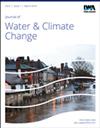Quantifying the influence of climate change on streamflow of Rietspruit sub-basin, South Africa
IF 2.7
4区 环境科学与生态学
Q2 WATER RESOURCES
引用次数: 0
Abstract
This study integrated climate projections from five global climate models (GCMs) into the soil and water assessment tool to evaluate the potential impact of climate alterations on the Rietspruit River sub-basin under two representative concentration pathways (RCP4.5 and 8.5). The model's performance was evaluated based on the coefficient of determination (R2), percent bias (PBIAS), Nash–Sutcliffe efficiency (NSE), probability (P)-factor and correlation coefficient (R)-factor. Calibration results showed an R2 of 0.62, NSE of 0.60, PBIAS of 20, P-factor of 0.86 and R-factor of 0.91, while validation produced an R2 of 0.64, NSE of 0.61, PBIAS of 40 and P-factor of 0.85 and R-factor of 1.22. Precipitation is predicted to increase under both RCPs. Maximum temperature is projected to increase under both RCPs, with a major increase in the winter months. Minimum temperatures are projected to decrease under RCP4.5 in the near (−0.99 °C) and mid (−0.23 °C) futures, while the far future is projected to experience an increase of 0.14 °C. Precipitation and temperature changes correspond to increases in streamflow by an average of 53% (RCP4.5) and 47% (RCP8.5). These results indicate a need for an integrated approach in catchment water resource management amid potential climate and land use variations.量化气候变化对南非里特斯普雷特子流域溪流的影响
本研究将五个全球气候模型(GCMs)的气候预测结果整合到水土评估工具中,以评估在两种具有代表性的浓度路径(RCP4.5 和 8.5)下,气候变化对里特斯普里特河子流域的潜在影响。根据判定系数 (R2)、偏差百分比 (PBIAS)、纳什-苏特克利夫效率 (NSE)、概率 (P) 因子和相关系数 (R) 因子对模型的性能进行了评估。校准结果显示,R2 为 0.62,NSE 为 0.60,PBIAS 为 20,P-因子为 0.86,R-因子为 0.91;验证结果显示,R2 为 0.64,NSE 为 0.61,PBIAS 为 40,P-因子为 0.85,R-因子为 1.22。根据两种 RCP 预测,降水量都将增加。在两种 RCPs 条件下,预计最高气温都将升高,主要集中在冬季。预计在 RCP4.5 下,近期(-0.99 °C)和中期(-0.23 °C)的最低气温将下降,而远期将上升 0.14 °C。降水量和温度的变化与溪流平均增加 53% (RCP4.5)和 47% (RCP8.5)相对应。这些结果表明,在潜在的气候和土地利用变化中,需要采用综合方法进行集水区水资源管理。
本文章由计算机程序翻译,如有差异,请以英文原文为准。
求助全文
约1分钟内获得全文
求助全文
来源期刊

Journal of Water and Climate Change
WATER RESOURCES-
CiteScore
4.80
自引率
10.70%
发文量
168
审稿时长
>12 weeks
期刊介绍:
Journal of Water and Climate Change publishes refereed research and practitioner papers on all aspects of water science, technology, management and innovation in response to climate change, with emphasis on reduction of energy usage.
 求助内容:
求助内容: 应助结果提醒方式:
应助结果提醒方式:


